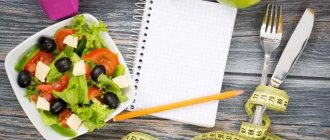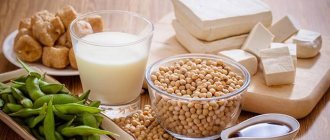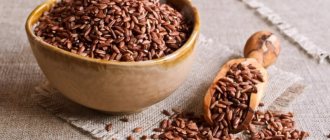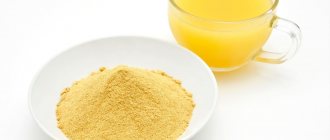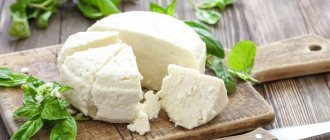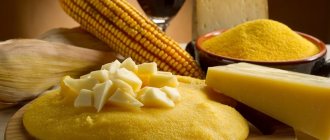Classification and structure of fats
From a biochemical point of view, fat molecules are classified as acids and are divided into two main types: saturated and unsaturated.
Natural fats are heterogeneous in their chemical composition; their physical properties and taste are largely determined by the different ratios of the saturated and unsaturated fatty acids they contain.
Saturated fats
Saturated fats (saturated acids) are simple in structure, in them the bonds between carbon atoms are saturated to the limit, so they are inactive from a biological point of view.
| Most saturated fats are not completely absorbed by the body (80-90%). The higher the saturation of fat, the more likely it is to remain in the body (in the circulatory system). |
Saturated fats in excess amounts can increase total cholesterol levels due to the simultaneous increase in both “bad” and “good” cholesterol, so it is important to observe moderation in their consumption (for recommended amounts, read the section “Issues of eating fats”), avoid you can't avoid them completely.
As a rule, these fats are solid at room temperature (lard, oil), with the exception of two types of vegetable oil - palm and coconut.
Unsaturated fats
Unsaturated fats (acids) contain one (monounsaturated) or more (polyunsaturated) “fragile” bonds in the molecule, at the site of which hydrogen can attach; they react more easily with other substances.
| Unsaturated fats have a low melting point. They are absorbed in the body much more easily than saturated ones and perform more important functions. |
Monounsaturated fats increase good cholesterol levels and also contain omega-9 fatty acids (oleic acid).
Oleic acid is responsible for the permeability of cell membranes, which decreases with its deficiency, therefore, metabolism is also disrupted. Olive oil, for example, is rich in oleic acid.
Polyunsaturated fats contain Omega-3 and Omega-6 fatty acids.
Omega-3 are polyunsaturated fats that are not reproduced in our body independently (they are essential), but play a vital role.
Omega-3s are introduced into cells and affect their structure and activity. Hence their variety of beneficial properties: they improve the functioning of the heart, brain, eyes and joints, and reduce the level of “bad” cholesterol in the blood. These fats reduce inflammation, play a role in lowering blood pressure, and are excellent antioxidants. Omega-3 fatty acids are especially important during pregnancy and breastfeeding.
Sources of Omega-3: flax and chia seeds, salmon, walnuts, Chinese cabbage.
Omega-6 fats are also essential. They are necessary for the growth and synthesis of compounds such as hormones, to protect the body from many diseases (heart disease, various forms of allergies, cancer, premature aging, etc.).
Sources of Omega-6: sunflower seeds, poppy seeds, sesame seeds, walnuts, soybeans, corn and their oils.
With a deficiency of Omega-3 fatty acids, Omega-6 fatty acids exhibit properties opposite to their positive ones. Therefore, the balance of these fats in the food entering our body is important. Omega-3 and Omega-6 should be consumed in certain proportions - recommended ratios range from 5-10:1 Omega-6:Omega-3.
| To meet the physiological needs of an adult (5-10 g/day Omega-6 and 0.6-1.6 g/day Omega-3), for example, you can consume 1-2 teaspoons per day of flaxseed oil, which is the most balanced in terms of Omega-3 and Omega-6 fatty acids. |
It is important to know that Omega-3 and Omega-6 fatty acids are highly susceptible to oxidation. When fats are heated and exposed to air, oxidation occurs faster.
| WHO experts say that unsaturated fats are preferable to saturated fats. However, the body needs both saturated and unsaturated fats to function properly. |
Trans fats
Industrial trans fats are formed when unsaturated fats harden (hydrogenate). Ultimately, liquid vegetable oils are converted into solid oils such as margarine, spread, soft butter mixtures or shortening.
These types of fats are widely used in the food industry, including to extend the shelf life of products. It is a common practice to add trans fats to increase the fat content of curd masses, processed cheese, ice cream, etc.
Minor amounts of trans fats can be formed when oils are heated for long periods of time during frying at high temperatures.
| WHO states that industrial trans fats are not part of a healthy diet. They are very harmful and you should not eat such fats. |
Trans isomers , which are formed during the process of hydrogenation, harm the hormonal and enzyme systems of the body, promote the accumulation of toxins, and increase the risk of developing many diseases - from atherosclerosis and obesity to diabetes and cancer.
Industrial trans fats in a product can be identified on labels by the words “hydrogenated” or “ partially hydrogenated” . However, the absence of these words does not guarantee that there are no trans fats in the composition.
Small amounts of naturally occurring trans fats are found directly in some meat and dairy products (eg, beef, lamb, butter). The composition of natural trans fats differs from industrial ones. There is not yet enough research to answer the question of the effect of natural trans fats on the human body.
The main sources of all described groups of fats are presented in the infographic:
| Saturated fats are often attributed numerous harmful properties, confusing them with trans fats. The differences in their effects are shown in the table. |
The effects of saturated fats and trans fats on various systems and changes in the body
Recommendations for creating a complete diet
- Hearty breakfast
– from 7:00 to 10:00. If you do not have adrenal fatigue and are prone to hypoglycemia, you can move your first meal closer to noon and thus combine it with lunch.
The ideal formula, following which, you will remember the feeling of hunger no earlier than after 4-5 hours:
- Fats up to 60%.
- Protein 20-40%.
- Carbohydrates 20%.
- Full lunch
– from 12:00 to 14:00. Try to adhere to the following ratio:
- Fats - 15%.
- Protein - 25%.
- Fiber (greens and vegetables) - up to 60%.
- Mostly plant-based dinner
5:00 pm to 6:00 pm is the optimal time to do a relatively easy version of intermittent fasting. Approximate formula:
- Fats up to 15%.
- Carbohydrates up to 75%.
- Protein up to 15%.
Good sources of fat include: avocados, coconut yogurt with paleo granola, olives, keto coffee (with a pat of coconut oil or GHI added), nut milk, full-fat aged cheeses, pine nuts and walnuts, pumpkin seeds, seeds chia, almonds, pistachios, pecans, flax, cashews, cod liver, keto almond flour bread, tahini.
You can get protein from fatty fish, shrimp, scallops, squid, eggs, poultry, vegetable protein, tofu and chickpeas.
Breakfast carbohydrates: quinoa, millet, buckwheat, gluten-free bread, brown rice, amaranth, kale, corn, spinach, arugula, bok choy, chard, watercress, romaine, strawberries, blueberries, blueberries, mango, cherries, pineapple, raspberries , blackberries, goji, pumpkin, carrots, tomatoes, radishes, broccoli, cauliflower, Brussels sprouts.
Bake fish, prepare grilled vegetables and puree pumpkin, cauliflower or broccoli as a side dish. Lamb pilaf, rabbit or poultry - experiment and find new combinations!
A large bowl of vegetable salad with probiotic dressing is ideal - 3-4 types of vegetables: boiled, baked, fermented, raw. You can add one or two flax breads with hummus or tahini - the food should be light and not burdensome.
Digestion of fats
When digested, fats are broken down into glycerol and fatty acids, from which fats are then synthesized in the intestines and released into the blood. The fatty acids are then stored in fat cells. Not all fatty acids supplied with food are completely absorbed by the body, as many nutritionists mistakenly believe. They may not be partially or completely absorbed in the small intestine and may be excreted from the body.
The origin and chemical composition of fats also affects their absorption:
1. Saturated fatty acids and trans fats tend to be stored in fat stores rather than immediately burned through energy metabolism. 2. Monounsaturated fatty acids are mainly used directly after absorption. In addition, they help reduce glycemia, which reduces insulin production and thereby limits the formation of fat reserves. 3. Polyunsaturated fatty acids , especially Omega-3, are always consumed immediately after absorption, in particular, due to an increase in food thermogenesis - the body’s energy consumption for digesting food. In addition, they stimulate lipolysis (the breakdown and burning of fat deposits).
Cholesterol
The nutritional and biological value of fats is also related to the content of phospholipids and sterols. The most famous human representative of the group of sterols is cholesterol.
Cholesterol is an important component of cell membranes and cytoplasm; it is involved in the exchange of bile acids and in the synthesis of hormones of the adrenal cortex and gonads. Cholesterol is used for the formation of bile in the body, the synthesis of vitamin D, and also performs a protective function - it is involved in the emergency “repair” of cell membranes.
Despite all these beneficial properties, cholesterol is primarily perceived by many as the cause of cardiovascular disease and the occurrence of “cholesterol plaques.” The thing is that there are two types of cholesterol. To make it easier to understand the issue, study the infographics.
The concentration of cholesterol in the blood can be determined using a blood test. In this case, as a rule, the total cholesterol level, the level of HDL and LDL and the atherogenic coefficient are determined - the proportional ratio of total and “good” cholesterol. Abnormally high levels of both HDL and LDL require attention, monitoring, additional testing and possibly treatment.
| Major factors that can increase total blood cholesterol (LDL cholesterol in particular) include heredity, excessive consumption of foods high in saturated fat, being overweight, lack of physical activity, and high levels of stress. |
Scientists have found that a combination of all or several of these conditions is necessary to increase cholesterol levels.
Is cholesterol really that bad?
More recently, it was accused of all human sins, considering it the primary cause of almost all pathologies of the cardiovascular system. A new trend for low-fat products has emerged - every second manufacturer loudly announced this in bold letters on the packaging. True, the carbohydrate content in them also increased sharply - however, so far few have paid attention to this.
We recommend
“What is dietetics and nutritionology: what are their differences” Read more
Whether we like it or not, we need cholesterol just like, say, proteins: even based on the simple logic that otherwise it would not be synthesized inside our body. So, it is nothing more than a raw material for the formation of sex hormones, adrenal hormones and, of course, vitamin D.
Low-fat diets always lead to disruptions in the menstrual cycle: what are its conductors formed from if all sources of income are either strictly limited or completely excluded?
Cholesterol is part of cell membranes, participates in the construction of the myelin sheath, which ensures isolated propagation of impulses along nerve fibers; its significant concentrations are observed in the white matter of the brain.
Functions of fats in the body
Fats are nutrients with many important functions in the body, the main ones being:
- energy - a source of energy for the body, which is twice as energetic as proteins and carbohydrates;
- structural
– material for building healthy cell membranes, in which fats affect the internal processes of the cell (the human brain is 60% fat).
Additional functions of fats:
- Participate in metabolic processes (form membranes, synthesize a number of hormones);
- Serve as shock absorbers, enveloping the main organs of the body;
- Take part in protecting the body from hypothermia and overheating;
- Responsible for the absorption of fat-soluble vitamins (A, D, E, K) and fat-soluble antioxidants (lycopene and beta-carotene);
- They supply the body with complexes of enzymes, minerals, and vitamins;
- They are a source of water after oxidation in the body.
How to remove fat from the stomach and sides in women?
Liposuction of the abdomen and sides is an aesthetic operation that will help locally remove fat from these problem areas and restore natural and clear contours of the figure in both women and men.
And what is most important is that you will see the result immediately after the operation, on the same day.
In the photo: The patient underwent liposuction in the area of fat traps of the hips and waist. How easy it is to get rid of fat deposits with the help of liposuction and restore a slender silhouette!
Including fats in the diet
The main preferred sources of fat for forming a diet and recommended consumption amounts are presented in the infographic above.
| When frying in oil, it is important to consider the stability of the oil when heated (table in the section “Issues of eating fats”), since not all of them are stable when heated. If possible, it is better to minimize this type of frying. |
Choose cooking methods such as stewing in water, steaming, baking in the oven, or grilling. Remove fat that forms during cooking of meat and fish.
When including foods such as commercial baked goods (cookies, donuts, muffins, cakes, pizza dough), packaged snacks (crackers, microwave popcorn, chips), fried foods (french fries, fried chicken, chicken nuggets, breaded fish ), sweets, it is important to remember that they most likely contain trans fats that are harmful to the body.
Preference should be given to low-processed fats (for example, butter rather than margarine), because In the process of technological processing and long-term (or incorrect) temperature treatment at home, most of the beneficial properties of the product are lost, only its energy value is retained.
Dietary fats must be fresh, as they quickly oxidize and accumulate harmful compounds.
Rehabilitation after liposuction of the abdomen and sides
Rehabilitation after liposuction of the abdomen and sides averages approximately 3 weeks. For some, this period is a little less or a little longer due to the individual characteristics of the body. Bruising and swelling may occur after surgery. Do not be alarmed by them - this phenomenon is quite normal after this kind of intervention. The bruises go away pretty quickly.
Do not neglect wearing compression garments, which are specially created to avoid sagging of excess skin after liposuction and to form the correct body contour.
For some time you will have to exclude heavy loads, sports, tanning, visiting the sauna and swimming pool.
2 weeks before and 2 weeks after surgery you need to stop smoking and taking blood thinning medications.
The main thing is to follow all the doctor’s recommendations and advice during the rehabilitation period.
Comment by candidate of medical sciences, plastic surgeon Svetlana Nikolaevna Zharkova
I always tell my patients that successful surgery is only 50% of the work towards a perfect figure.
At this stage, my work is over and yours begins, where you need to properly care for yourself in order to ultimately get an ideal result that will delight you for many years. Do not neglect all the advice of the plastic surgeon and if you have any questions, you can seek advice after the operation. If complications arise or something bothers you, the main thing is to report it in a timely manner.
Peculiarities
Fat oxidation
When frying foods (heating oil), some oils oxidize, and we see that the oil begins to smoke. Acrolein is formed in the fumes above the frying pan.
– a particularly toxic substance that irritates the mucous membranes of the eyes and respiratory tract. In addition, free radicals and fatty acid polymers are formed, which can cause cancer. Moreover, the listed harmful components can occur during long-term storage and without exposing the oil to high temperatures.
The most important factor influencing an oil's resistance to oxidation at both high and low temperatures is the relative amount of saturated fat (indicated in red) in its composition: the higher the saturated fat content, the more resistant the oil is to heat.
| Numerous studies show the need to limit your intake of polyunsaturated fats (blue) in favor of monounsaturated fats (yellow), which are also highly resistant to oxidation. |
Vegetable oils
Vegetable oils are produced from the seeds and fruits of oilseed crops: sunflower, corn, soybeans, rapeseed, pumpkin, and cotton. Separately, there are kernel oils (for example, grape or watermelon seed oil), nut oils (almond, peanut), oils from soft tissues of plants (for example, from avocado pulp or from coconut palm fruits).
Vegetable oils are obtained by pressing and extraction. Pressing can be hot or cold, and for additional purification the oils are subjected to filtering, refining (exposure to alkalis) and deodorization (odor removal).
Oil obtained by extraction using special solvents is suitable for food only in refined form.
When cooking, preserving and refining oils, their biological benefits are lost or reduced, while their energy value remains, and harmful oxidation products can accumulate.
| When cold pressed/pressed (preferably first/extra virgin) in unfiltered and non-deodorized oils, the beneficial properties are preserved as much as possible. |
It is preferable to use lightly processed oils in their pure form. For frying, it is better to use refined oil. Repeated heating of fats should be avoided as at the same time, carcinogens are formed in them.
Oil bottled in dark glass with a short shelf life (usually no more than 12 months) is likely to be more natural than oil without color, odor, without signs of raw materials and with a longer shelf life.
Preoperative markings before liposuction and photos after
A
The photo shows preoperative markings and fat deposits on a woman’s body. As a result of liposuction, 7.5 liters of fat were removed from this patient, and accordingly her weight decreased and her figure became more youthful and toned.
Comment by candidate of medical sciences, plastic surgeon Svetlana Nikolaevna Zharkova, Moscow:
There are much more liposuction areas in women than in men, and they affect not only the stomach and sides, but also the legs and arms.
In the photo above you can see how my patient’s body has changed after removing fat from her abdomen and sides using surgical liposuction.
With the help of liposuction, you can quickly remove excess fat from the abdomen and sides and return the female figure to its former slimness and fit. No more hiding your belly under baggy T-shirts and sweatshirts. Modern plastic surgery does not stand still.
My dear women, today you can correct your figure in almost one day!
Liposuction has the least trauma and minimal side effects.
If you are looking for a solution to the problem of how to remove excess fat from the stomach and sides, please contact us.
Together we will return your body to a slender silhouette.
Issues with eating fats
| How much fat should you eat per day? |
Fats contain the greatest amount of energy compared to other macronutrients - 9 kcal/g. The amount of fat that should come from food depends on many factors: your age, health status, amount of physical and mental activity, climatic conditions of your residence.
| Experts from different countries in the field of nutrition have established that a person needs to receive no more than 20-35% (WHO indicates <30%) of daily total energy from fats. |
In this case, the norms for adults:
- saturated fatty acids – no more than 10% (no more than 1/3 of the total fat);
- monounsaturated fatty acids – 10% (1/3 of the total fat);
- polyunsaturated fatty acids – 6-10% (≤1/3 of the total amount of fat), of which 5-8% of the daily caloric intake for Omega-6 and 1-2% for Omega-3.
The WHO fact sheet (September 2015) states that reducing total fat intake to less than 30% of total energy helps prevent unhealthy weight gain among adults .
The risk of developing non-communicable diseases is reduced by reducing saturated fats to less than 10% of total energy, and trans fats to less than 1% of total energy and replacing them with unsaturated fats, which are found in vegetable oil.
It is important not to allow either a deficiency or excess of fat in the diet.
Fat deficiency:
- worsens the condition of the skin (dryness and pustular diseases appear), hair;
- delays the growth and development of a growing organism;
- disrupts reproductive function in women (amenorrhea may occur);
- disrupts cholesterol metabolism;
- negatively affects the functioning of the nervous system and brain, leading to symptoms of depression;
- leads to a deficiency of vitamins that are soluble only in fats.
Excess fat:
- leads to obesity (hence, mobility decreases, appearance deteriorates, the cardiovascular system malfunctions, blood composition deteriorates, the risk of stroke, atherosclerosis, coronary heart disease, hypertension and other diseases increases);
- causes a threat of damage to the liver, pancreas, development of cancer, cholelithiasis.
| What should I do if I have high cholesterol? |
First of all, you need to find out which cholesterol (“good” or “bad”) is responsible for the increased level of total cholesterol. If the proportion of “good” cholesterol is increased, high total cholesterol is not really a warning factor.
If your LDL cholesterol level increases, you should consult your doctor!
| General recommendations: To reduce “bad” cholesterol, it is better to supplement a balanced diet with physical activity, maintain a healthy weight, reduce stress and not smoke. |
It is not recommended to completely abandon the consumption of animal fats and replace them with vegetable fats (although advice on replacing fats can often be heard from nutritionists).
To date, scientific data on the effect of saturated fats on the development of cardiovascular diseases and mortality from them are contradictory. It has been established that vegetable fats reduce the level of “bad” cholesterol (LDL), but at the same time they often reduce the level of “good” cholesterol (HDL) , which is exactly the situation that can increase mortality from diseases of the cardiovascular system.
Foods high in soluble fiber (fruits, vegetables, oats, legumes) can help lower bad cholesterol levels in the blood. Foods rich in soy protein (tofu, soybeans, soy milk) may also help reduce cholesterol levels slightly.
| Is it true that adding vegetable oil to foods helps absorb vitamins from them? |
Yes, there are a number of vitamins (A, D, E, K) that are fat soluble. They enter the body from food and are stored in fatty tissues. For example, carrots (a source of provitamin A - beta-carotene) are best eaten with butter or sour cream. Salads containing green leafy vegetables and cabbage (a source of vitamin K) are also seasoned with oil.
| If I do decide that I want a fried dish, what oil is best to cook it in? |
When choosing an oil for frying, an important characteristic is its smoke point (the temperature at which the oil begins to break down and become unsuitable for food). Visually, the oil begins to smoke. Refining oils increases their smoke point.
Frying of the product occurs at a temperature of more than 100 degrees, the formation of a golden crust occurs at 140-165 degrees. Thus, it is preferable to fry in oil that has a smoke point of 160 degrees or higher.
It is better to pour oil into a cold frying pan, and when it heats up, immediately start frying.
We offer for consideration a table reflecting the characteristics of the most preferred fats and oils for frying:
| Oils | Lipid composition, % | Recommended Application | Useful Features | ||
| Monounsaturated | Polyunsaturated | Saturated | |||
| Coconut oil | 6 | 2 | 92 | Browning meat, searing, deep frying | No cholesterol |
| Palm kernel oil | 12 | 2 | 86 | Browning meat, searing, deep frying | No cholesterol. Stores well at room temperature. Rich in vitamin K. |
| Butter | 28 | 4 | 68 | Best for baking, roasting or stewing. For frying at high temperatures, it is recommended to use ghee or ghee. | Contains vitamins A, E, K2. Rich in conjugated linoleic acid (CLA) fatty acids and butyrates. CLA can reduce body fat in humans, butyrates are involved in fighting inflammation, helping reduce obesity and stimulating bowel function. |
| Ghee oil | 30 | 5 | 65 | Browning meat, searing, deep frying | Stores well at room temperature. High smoke point - about 500⁰. During the production process, the amount of lactose and casein is reduced to a minimum, so this oil is suitable for people intolerant. Rich in vitamins A, D, E, and K. |
| Palm oil | 38 | 10 | 52 | Browning meat, searing, deep frying | Red palm oil (unrefined) is better. It is rich in vitamin E, coenzyme Q10 and other beneficial substances |
| Animal fats – lard, beef, chicken fat, bacon | 44-47 | 4-22 | 31-52 | Light roasting, stewing | The composition and beneficial properties vary greatly depending on the species and food supply. |
| Olive oil | 78 | 8 | 14 | Stewing, frying at low temperatures (peeled). Dressing and adding to prepared dishes (extra virgin) | The higher the degree of purification, the higher the smoke point. Oil with the highest content of monounsaturated fatty acids. Increases HDL levels. Activates the secretion of bile and pancreatic hormones. |
| Canola (rapeseed oil) | 62 | 31 | 7 | Stewing, frying at low temperatures | High levels of monounsaturated fats increase HDL levels. Contains small amounts of Omega-3 |
| Avocado oil | 73 | 19 | 18 | Roasting at high temperatures, browning meat | Due to the high content of polyunsaturated fats, it is not recommended for everyday use. Contains vitamin E. |
| Nut butters (peanut, almond, hazelnut, macadamia) | 48-84 | 3-34 | 7-18 | Dressing, adding to prepared dishes. Not recommended for frying | They have unique taste characteristics, but most are rich in polyunsaturated fats, which makes them unsuitable for everyday use. The exception is macadamia oil. |
| Flaxseed, hemp, sesame, unrefined sunflower oil, wheat germ oil, cottonseed oil | — | — | — | Not suitable for heating. May have limited use in some dishes. For food purposes, cottonseed oil must be refined, because unrefined oil contains a toxic substance - gossypol. | You must read the label carefully - it may contain trans fats! |
| How to store and use oils? |
Let's look at the example of butter, olive and flaxseed oils.
good butter should have a dense, uniform consistency with a slightly shiny or slightly matte surface, a shiny cut, and a uniform color from light yellow to yellow. A slightly crumbly consistency or the presence of tiny single droplets of moisture is acceptable.
Unused butter is stored in the refrigerator away from strong-smelling foods at a relative humidity of no more than 90% for 10 to 30 days, depending on the type of packaging (for example, butter is stored better in foil than in parchment). However, if you purchased too much butter, know that its shelf life at a storage temperature not exceeding minus 25°C ranges from 6 to 24 months.
Like many other vegetable oils, olive oil in small quantities, in dark glass bottles.
The beneficial properties of olive oil are preserved for 5-12 months from the date of production; over time, it deteriorates and expires, and acidity increases. After opening, it should be stored hermetically sealed, in a dark, dry, cool place, protected from strong odors, preferably consumed within a month.
In the cold (for example, in the refrigerator), it may become cloudy and produce a small sediment - if there is no sudden separation of the liquid, everything is in order. After heating to room temperature, the sediment should disappear, and the oil should return to transparency, but the oil may lose its taste.
Flaxseed oil is more prone to oxidation compared to olive oil, so you should monitor its storage conditions even more carefully. The oil should also be stored in a light-protected glass container with a tightly closed neck (lid). The smaller the volume of the purchased portion, the better; after opening, the oil can be stored for no more than 30 days in a cool, dark place (at a temperature no higher than +10 degrees). Be sure to pay attention to its expiration date (no more than 6 months from the date of spinning).
Authors: Elena Degtyar, PhD, head of the scientific department of the #SEKTA School, Anastasia Kokoulina, employee of the scientific department of the #SEKTA School, Maria Kardakova, MSc, Alexandra Romek, MSc
References: 1. Popkin, BM (2012) Global nutrition transition and the pandemic of obesity in developing countries. Nutrition reviews 70 (1): pp. 3 -21. Access date: 11/06/2016 – 01/30/2017 2. All about cholesterol: national report; edited by Academician of the Russian Academy of Medical Sciences L. A. Bockeria, Academician of the Russian Academy of Medical Sciences R. G. Oganov. – M.:NTsSSKh them. A. N. Bakuleva RAMS, 2010. – 180 p. Access date: 11/06/2016 - 01/30/2017 3. Understanding Cholesterol - Dr. Fiona Dulbecco, MD. Date of access: 11/06/2016 - 01/30/2017 4. Simopoulos AP Essential fatty acids in health and chronic disease //The American Journal of Clinical Nutrition. – 1999. – T. 70. – No. 3. – pp. 560s-569s. Date accessed: 11/06/2016 - 01/30/2017 5. Torpy, J. M., C. Lynm, and R. M. Glass. 2006. Eating fish: Health benefits and risks. JAMA 296:1926. Date accessed: 11/06/2016 - 01/30/2017 6. McNamara, R. K., and S. E. Carlson. 2006. Role of omega-3 fatty acids in brain development and function: Potential implications for the pathogenesis and prevention of psychopathology. Prostaglandins Leukot Essent Fatty Acids 75:329–49. Access date: 11/06/2016 – 01/30/2017 7. St-Pierre AC et al. Low-density lipoprotein subfractions and the long-term risk of ischemic heart disease in men 13-year follow-up data from the Québec Cardiovascular Study //Arteriosclerosis, thrombosis, and vascular biology. – 2005. – T. 25. – No. 3. – pp. 553-559. Access date: 11/06/2016 – 01/30/2017 8. Campos H. et al. Low density lipoprotein particle size and coronary artery disease //Arteriosclerosis, thrombosis, and vascular biology. – 1992. – T. 12. – No. 2. – pp. 187-195. Date of access: 11/06/2016 - 01/30/2017 9. Gardner CD, Fortmann SP, Krauss RM Association of small low-density lipoprotein particles with the incidence of coronary artery disease in men and women //Jama. – 1996. – T. 276. – No. 11. – pp. 875-881. Access date: 11/06/2016 – 01/30/2017 10. Greene CM et al. Maintenance of the LDL cholesterol: HDL cholesterol ratio in an elderly population given a dietary cholesterol challenge //The Journal of nutrition. – 2005. – T. 135. – No. 12. – pp. 2793-2798. Date of access: 06.11.2016 - 30.01.2017 11. Fernandez ML Dietary cholesterol provided by eggs and plasma lipoproteins in healthy populations //Current Opinion in Clinical Nutrition & Metabolic Care. – 2006. – T. 9. – No. 1. – pp. 8-12. Access date: 11/06/2016 — 01/30/2017 12. Eyres L, Sherpa N and Hendriks G: Avocado oil: a new edible oil from Australasia. Lipid Technol 2001;Vol 13, no 4:84-88. Date of access: 06.11.2016 - 30.01.2017 13. Norms of physiological needs for energy and nutrients for various groups of the population of the Russian Federation Methodological recommendations MR 2.3.1.2432 -08. Access date: 11/06/2016 – 01/30/2017 14. Ask the Expert: Healthy Fats // Harvard TH Chan. School of Public Health. Date of access: 06.11.2016 - 30.01.2017 15. Cardiovascular Disease and Milk Products: Summary of Evidence/Dairy nutrition Dedicated to Health Professionals Date of access: 06.11.2016 - 30.01.2017 16. Fats and oils in human nutrition. Report of a joint expert consultation. – FAO 1994. Date of access: 11/06/2016 - 01/30/2017 17. Robert L. Wolff. Heat-induced geometrical isomerization of α-linolenic acid: Effect of temperature and heating time on the appearance of individual isomers [Electronic resource]// Journal of the American Oil Chemists' Society. April 1993, Volume 70, Issue 4, pp 425–430 Date of access: 11/06/2016 - 01/30/2017 18. Fats and Cholesterol // Harvard TH Chan. School of Public Health. Date of access: 06.11.2016 - 30.01.2017 19. Przybylski O, Aladedunye FA. Formation of trans fats during food preparation. [Electronic resource]// Can J Diet Pract Res. 2012 Summer;73(2):98-101. Date of access: 11/06/2016 - 01/30/2017 20. Wakako Tsuzuki, Akiko Matsuoka, Kaori Ushida. Formation of trans fatty acids in edible oils during the frying and heating process [Electronic resource] //Food Chemistry.2010; vol. 123 issue 4: 976-982 DOI: 10.1016/j.foodchem.2010.05.048 Access date: 11/06/2016 — 01/30/2017 21. Frying Q&A. Trans Fat Help Date of access: 11/06/2016 - 01/30/2017 22. Jonathan Belsey et. al. Abnormal lipids in high-risk patients achieving cholesterol targets: a cross-sectional study of routinely collected UK general practice data [Electronic resource]// Current Medical Research and Opinion. Volume 24, 2008 - Issue 9. Date of access: 11/06/2016 - 01/30/2017 23. Patty W Siri-Tarino et. al. Meta-analysis of prospective cohort studies evaluating the association of saturated fat with cardiovascular disease [Electronic resource]// Am J Clin Nutr.2010. doi: 10.3945/ajcn.2009.27725 Date of access: 11/06/2016 - 01/30/2017 24. Healthy eating. WHO Information Bulletin N°394. September 2015 Date of access: 11/06/2016 - 01/30/2017 25. Benjamin Wedro. Cholesterol Management /MedicineNet.com Date updated: 27/10/2015 Date accessed: 11/06/2016 - 01/30/2017 26. 2015–2020 Dietary Guidelines for Americans Date accessed: 11/06/2016 - 01/30/2017 27. Dietary Guidelines for Americans, 2010 Date appeals: 06.11.2016 - 30.01.2017 28. R Uauy et. al. WHO Scientific Update on trans fatty acids: summary and conclusions [Electronic resource] //European Journal of Clinical Nutrition (2009) 63, S68–S75. doi:10.1038/ejcn.2009.15 Date of access: 11/06/2016 - 01/30/2017 29. Siri-Tarino PW et. al. Saturated fat, carbohydrate, and cardiovascular disease. [Electronic resource] // Am J Clin Nutr. 2010 Mar;91(3):502-9. doi: 10.3945/ajcn.2008.26285. Date of access: 06.11.2016 - 30.01.2017 30. Dias CB et. al. Saturated fat consumption may not be the main cause of increased blood lipid levels. [Electronic resource]//Med Hypotheses. 2014 Feb;82(2):187-95. doi: 10.1016/j.mehy.2013.11.036. Date of access: 11/06/2016 - 01/30/2017 31. Mu Chen et.al. Dairy fat and risk of cardiovascular disease in 3 cohorts of US adults [Electronic resource] // Am J Clin, 2021. doi: 10.3945/ Date of access: 11/06/2016 - 01/30/2017
Liposuction of the abdomen and sides in women
A woman's figure tends to change throughout her life, and sometimes it is very difficult for us to deny ourselves an extra cake or force ourselves to go for a run in the morning. Gaining excess weight and deposition of fat on the abdomen and sides occurs rapidly and almost imperceptibly. Pregnancy also adds problems to a woman's figure
A toned stomach and slender waist are becoming the cherished dream of many women.
When neither diet nor sports training helps, and looking at your reflection in the mirror becomes uncomfortable, liposuction comes to the rescue. To start talking about liposuction, I want to show you a photo of the abdomen and sides after surgery in my patients of different ages.
"Lifebuoy"
This is the name for excess weight that is concentrated around the hips. In this situation, your stomach really looks like a life preserver.
Reason: Your body is storing excess fat - most likely, you have been leading a sedentary lifestyle and eating unbalanced foods. In short, you consumed more calories than you burned.
What to do: Any physical activity will help. The most important thing is regularity of training. The UK's National Health Service recommends that all adults get at least 150 minutes of moderate-intensity exercise per week. Let this be your goal.
For the more advanced and experienced, high-intensity interval training (HIIT) is suitable, which is very effective in reducing fat percentage. Research shows that 20 minutes of HIIT exercise three times a week is as effective for weight loss as 30 minutes of moderate-intensity exercise daily.
Start by running. Run as fast as you can for 40 seconds, then rest for half a minute. Repeat for 20 minutes.
What to eat: To lose weight, you need to eat fewer calories than you burn. Lambert states: “Reducing your intake of saturated fat can be a good start.
Too much of them in your diet can lead to the accumulation of visceral fat around your organs. A Mediterranean diet with plenty of fatty fish, olive oil, grains and legumes has been shown to increase levels of good fat (HDL) and reduce levels of bad fat (LDL).”
